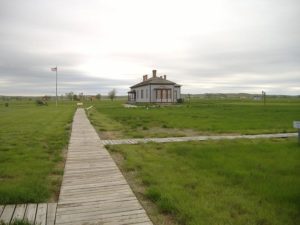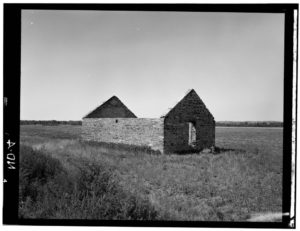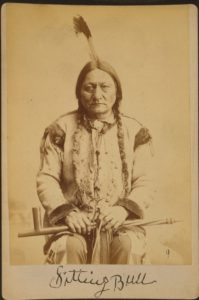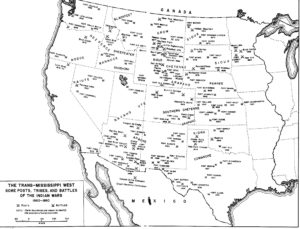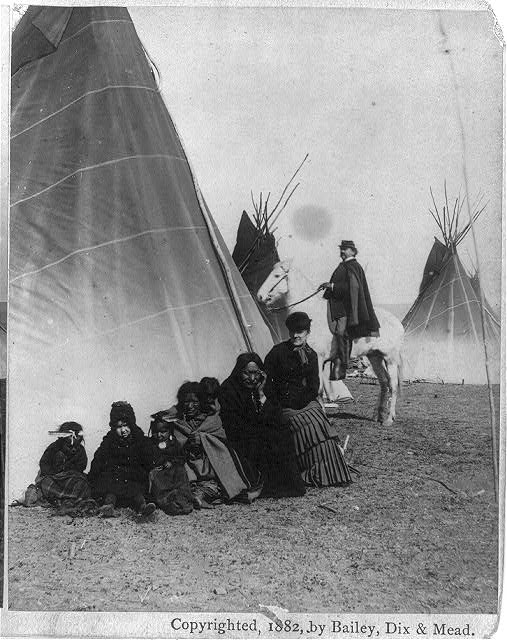I can’t keep up, and I’m getting slower. This has been a great hobby, and I am learning some facts about the Reconstruction era, but there seems like so much to try to understand. And I keep getting distracted. I was looking through some headlines trying to find something about Generals Ord and Pope as they took over their new military districts in the South, but I was drawn to a headline that said natives killed about eighty occupants of a fort out West, so I investigated.
From The New-York Times, April 2, 1867:
[Headlines]
WASHINGTON, Monday, April 1.
A letter from a wife of a distinguished Army officer at St. Louis, received here this morning, confirms the report of the capture of Fort Buford, at the mouth of the Yellow Stone, on the upper Missouri. Col. RANKIN, his wife, a child and the whole garrison were slaughtered, in all about eighty souls. …
The Philadelphia Inquirer of Monday morning, publishes the following extract from a private letter, dated Fort Sully, Dakotah Territory, Feb. 25, and received in that city on Saturday, concerning the affair mentioned above:
“There has been quite a stirring excitement in this part of the country with the red skins. I suppose you know of the Fort Kearney affair also. You ask me how far it is from us? It is about 1,500 miles northwest from here. By the upper mail, which arrived here to-day, we heard some very bad news from Fort Buford. There was one company of our regiment stationed there, under the command of Col. RANKIN. The Indians made an attack on that little band, and it appears from all accounts that they fought bravely until outnumbered by the red skins, who killed them all but the Colonel and wife. They then took them a few yards from the post, and having built a fire, tied the Colonel’s hands and feet and put him in the fire, while his wife was compelled to see him burning. After that was done they maltreated her in a shameful manner, and having rolled her up in a buffalo robe, they fastened her on a wild [?] horse and turned him loose. God only knows how long she was on the prairie, but it happened, very fortunately, that the mail carriers for that fort encountered her in that condition, and after they had heard who she was they took her in charge and returned with her and the mails to Fort Rice.
The Indians were 1,800 strong – our men only ninety-six. They fought them three days; but on the third day the Indians took the place, scalped all the dead, and those who were officers they cut up into small pieces and ate them. That is considered bravery. It will not be good for them if they make their appearance around this fort. We are very well guarded. There are six companies here – four of infantry, one of cavalry and one of artillery. The weather has been very cold. We have lost nearly all of our stock – frozen to death. …
What a horrible story … but it turns out that it was just a story. The letter was fictitious. I did some de facto fact-checking at Wikipedia’s article about Fort Buford; it seems that the reported massacre was a hoax:
The harassing raids and resulting lack of communication from the isolated post led to the perpetration of a hoax, the “Fort Buford Massacre”, purporting that the fort had been wiped out, Capt. Rankin captured and tortured to death, and Rankin’s wife captured and abused. The episode began when the Philadelphia Inquirer ran a story April 1, 1867, based on a letter allegedly written from the fort, which was then picked up and run the next day nationwide. It was given “legs” by a letter published April 6 in the Army and Navy Journal, attributed to the wife of a prominent Army officer, confirming the massacre. Although by April 4 many newspapers had begun to question the validity of the report, The Chicago Daily Times, Detroit Free Press, New York Daily Tribune, New York Times, and Boston Herald, among others, continued to feed the rumors with further stories for another month, many of them accusing the Army and the Johnson Administration of covering up the massacre. The hoax was eventually exposed by Rankin himself in correspondence to the war department.
Although the general harassing by the Lakota of Fort Buford lasted until the early 1870s, the worst was during that first year, June 1866 to May 1867. In May, the Missouri River thawed allowing the sternwheeler steamboat Graham to reinforce the garrison with additional riverboats arriving in June carrying Companies B, F, G, and part of E thereby enabling the garrison to better defend itself and allow for more permanent structures to be built.
Actually the New-York Times began publishing a few articles that doubted the truth of the massacre starting April 6th. By May 19th the paper had no doubt that the letter was false:
The Reported Massacre at Fort Buford
It is now authoritatively settled that the reported massacre at Fort Buford was a deliberate misrepresentation. Advices have been received from Col. RANKIN, bearing date subsequent to that of the alleged massacre. It is almost impossible to conceive a mind base enough to invent so malicious a falsehood, one so calculated to wring the feelings of those who had friends in that isolated garrison.
The story probably had its origin among emigrants’ agents, who were interested in turning the tide of emigration from the Northwest to points further South, and for the few weeks during which the reports of Indian outrages were uncontradicted it probably had its effect. The fact, however, that the garrison at Fort Buford was not massacred, as reported, does not lessen in the slightest degree the force of the criticism which that report revoked. … [The Indians are threatening and have killed some whites. There are many soldiers idling around Eastern states. They should be sent west to protect the emigrants.]
The Indian is naturally a coward when brought in conflict with the white man, and never attacks unless the superiority of numbers is with him. To save the Indians as well as the whites, troops should be sent to the plains. [especially cavalry. The garrisons are “baits to whet the bloody appetite of the Indians”. The Government hasn’t done anything to prevent a real massacre.]
Wikipedia’s Fort Buford article does say there was sporadic fighting with casualties between Lakotas (at least once led by Sitting Bull) and the garrison at Fort Buford from its beginning in June 1866.


